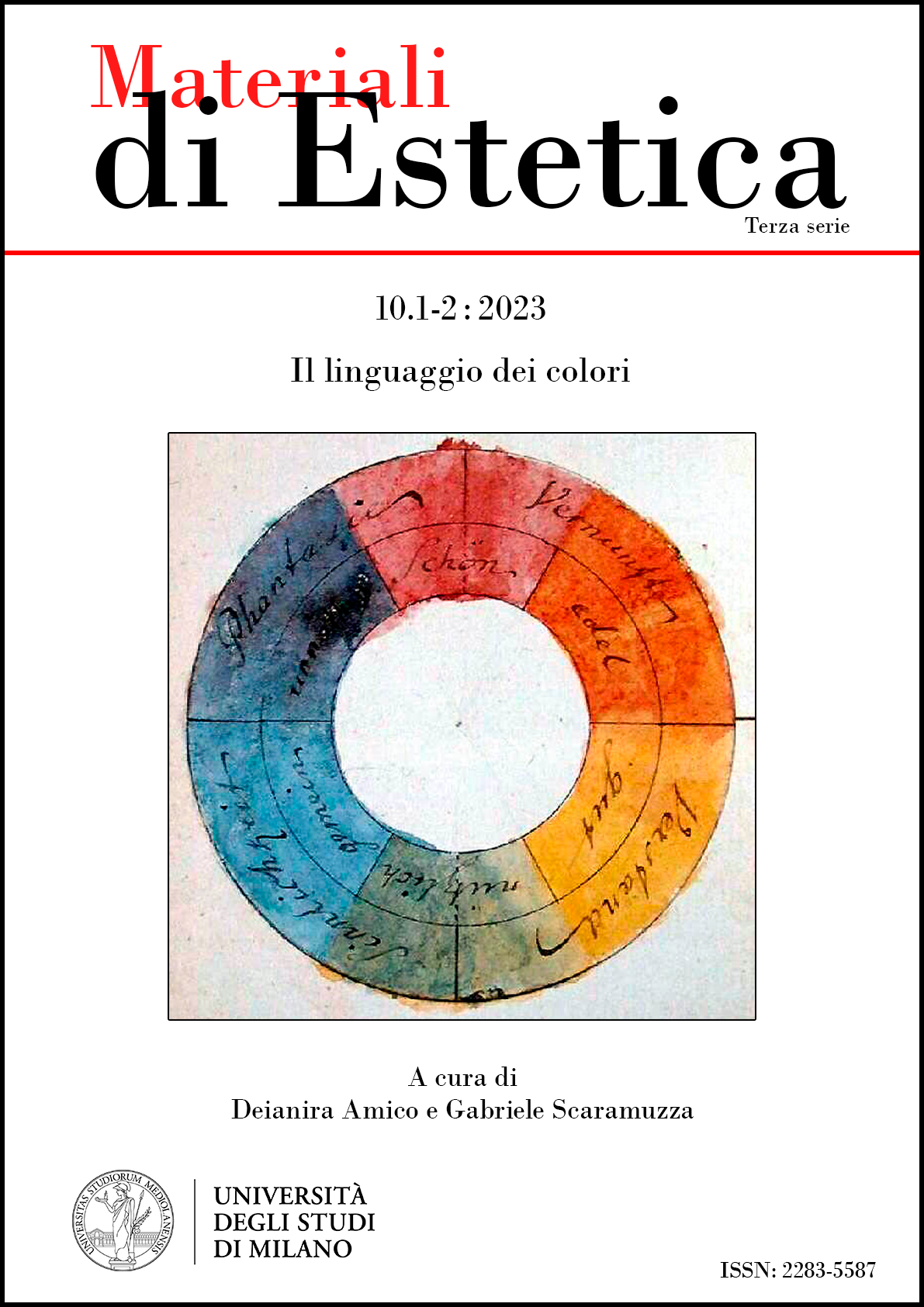I colori nel Giappone antico
DOI:
https://doi.org/10.54103/mde.i10.1-2.20674Parole chiave:
Ancient Japan culture, Aesthetic, ColourAbstract
For a long time, a tenacious prejudice has cultivated the idea that the West has produced the best ways of both knowing the world and organising existence. An integral part of this prejudice is the views on colour theories. Whether referring to the ancient Greeks, Goethe or Newton, for too long it has been thought (and sometimes still is thought) that it is the various Western colour theories that best describe the sensory experience that brings human beings into contact with colour. In a certain sense, that is, as theories, this is true. But it is not true that only colour theories allow us to have the best possible experience of colours. This observation is well illustrated by the case of ancient Japan, which lacked specific colour theories, but was very rich in colour sensitivity.
Riferimenti bibliografici
ADDISS, Stephen, GROEMER, Gerald, RIMER, J. Thomas, Traditional Japanese Arts and Culture, University of Hawaii Press, Honolulu 2006.
CLIFFE, Sheila, The Social Life of Kimono: Japanese Fashion Past and Present, Bloomsbury Academic, New York 2017.
DE BARY, William Theodore, The vocabulary of Japanese Aesthetics, in AA. VV., Sources of Japanese Tradition, Columbia University Press, New York 2001.
DEUTSCHER, Guy, La lingua colora il mondo. Come le parole deformano la realtà, Bollati Boringhieri, Torino 2013.
ELIADE, Mircea, Immagini e simboli, saggi sul simbolismo magico-religioso [1991], Jaca Book, Milano 2015.
FINLAY, Robert, Weaving the Rainbow: Visions of Color in World History, “Journal of World History”, University of Hawaii Press, 18, 4, 2007, pp. 383-431.
FOREMAN, Kelly, The Gei of Geisha. Music, Identity, and Meaning, Ashgate Press, London 2008.
GHILARDI, Marcello, Arte e pensiero in Giappone, Mimesis, Milano 2011.
HANE Mikiso, PEREZ, Louis G., Premodern Japan: a Historical Survey, Routledge, New York 2015.
HIBI Sadao, FUKUDA Kunio, The Colors of Japan: Background, Characteristics and Creation, Kodansha International, New York 2000.
ICHIRO Katayama, TSUTOMU Aoki, Analysis of Color Combinations in the Heian Period, “Kasane-Irome”, by using Color Affection Prediction Formulas in “Transactions of Japan Society of Kansei Engineering”, 9, 1, 2009, pp. 81-86.
KEENE, Donald, Japanese Aesthetics, in Id., Landscapes and Portraits: Appreciation of Japanese Culture, Kodansha International, Tokyo 1971.
KYOKO Aihara, Geisha: A Living Tradition, Carlton Books, London 2000.
MARRA, Michele, Essays on Japan: Between Aesthetics and Literature, Brill, Leiden 2010.
MATSUO Bashō (1644-1694), Lo stretto sentiero verso il profondo Nord, Einaudi, Torino 2022.
MURASAKI Shikibu, La Storia di Genji, traduzione di M. T. Orsi, Einaudi, Torino 2012.
NAGASAKI Seiki, Nihon no dentoshoku: Sono shikimei to shikicho, (I colori tradizionali del Giappone), Seigensha, Kyoto 2001.
ODIN, Steve, Artistic Detachment in Japan and in the West, University of Hawaii Press, Honolulu 2001.
ŌHASHI, Ryōsuke, Kire: il bello in Giappone, Mimesis, Milano 2018.
ORSI, Maria Teresa, Glossario, in Murasaki Shikibu, La Storia di Genji, traduzione di M. T. Orsi, Einaudi, Torino 2012.
—, The Colors of Shadows, in A. Boscaro e A. Hood Chambers (a cura di), A Tanizaki Feast: The International Symposium in Venice, University of Michigan Press, Ann Arbor 1998, p. 1-13.
PASQUALOTTO, Giangiorgio, Estetica del vuoto, Marsilio, Venezia 1992.
—, Figure di pensiero, Marsilio, Venezia 2007.
PASTOUREAU, Michel, Couleurs, Images, Symboles. Etudes d'histoire et d'anthropologie, Le Léopard d’Or, Paris 1986.
RICHIE, Donald, Sull’estetica giapponese, Lindau, Torino 2009.
SAIGYO (1118-1190), Storia di Saigyo, Einaudi, Torino 2010.
SAMBURSKY, Shmuel, SCHOLEM, Ghersom, CORBIN, Henry, Il sentimento del colore: l'esperienza cromatica come simbolo, cultura e scienza, Red, Como 1990.
SUN, Howard, I segreti dei colori, Sonzogno, Milano 1995.
TOSHIHIKO Izutsu, Il mondo colorato e incolore, in La filosofia del Buddhismo zen, Ubaldini, Roma 1984.
YOSHIMURA Takehiko, Kodai Ōken no Tenkai (Sviluppo della regalità antica), Shūeisha, Tokyo 1999.
Dowloads
Pubblicato
Fascicolo
Sezione
Licenza

Questo lavoro è fornito con la licenza Creative Commons Attribuzione - Condividi allo stesso modo 4.0.






